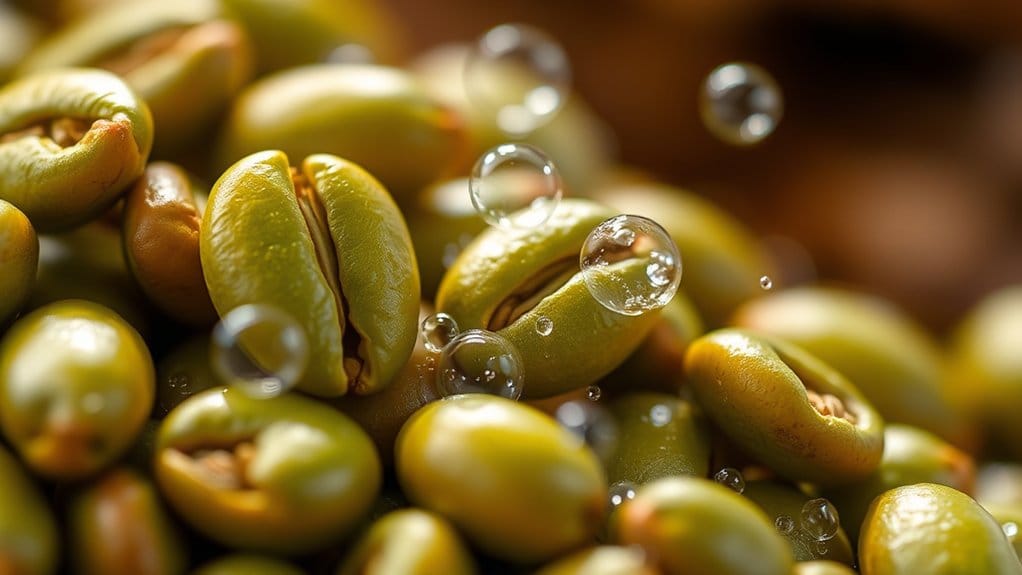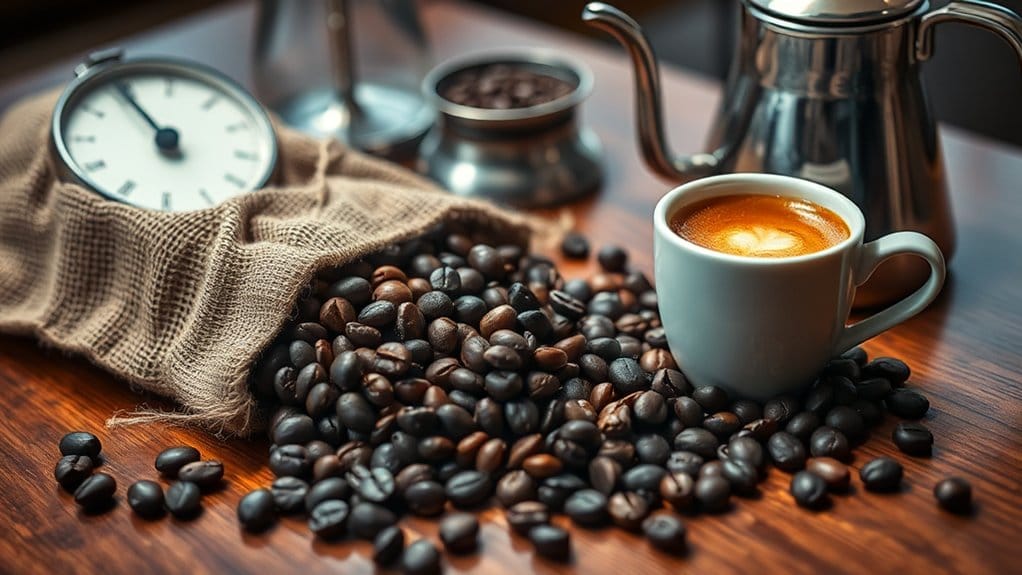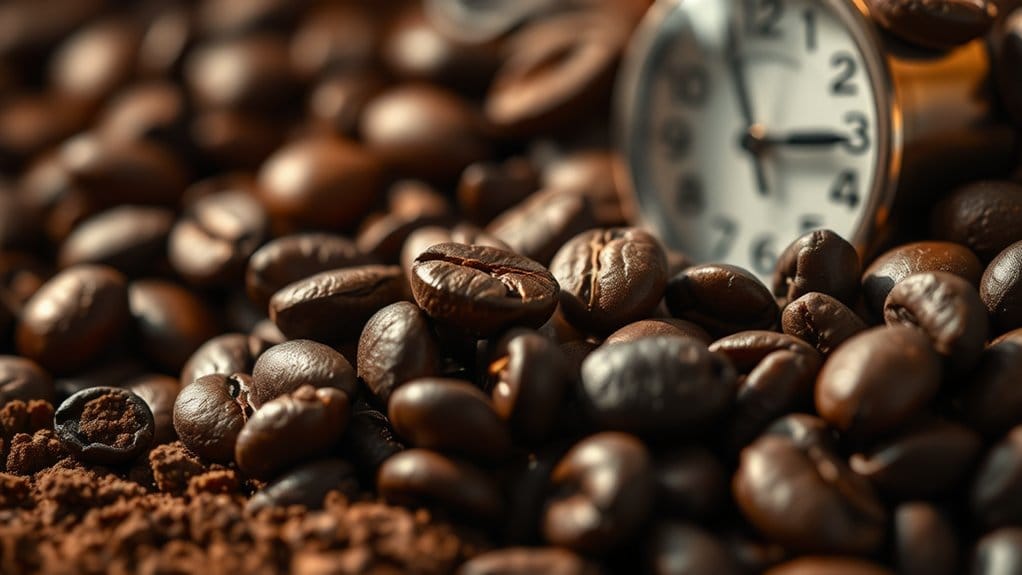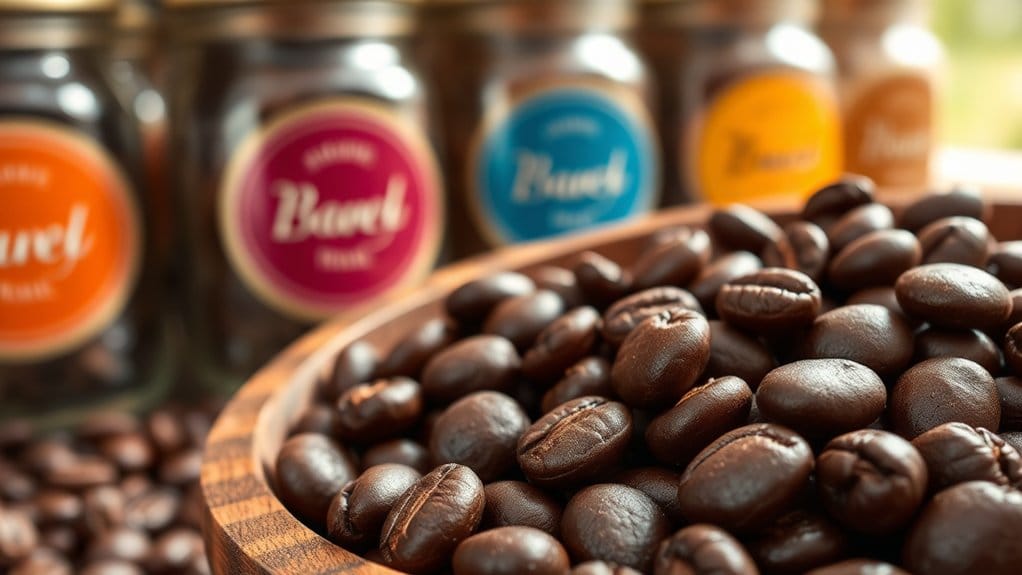Physical Address
304 North Cardinal St.
Dorchester Center, MA 02124
Physical Address
304 North Cardinal St.
Dorchester Center, MA 02124

Fresh coffee beans are like treasure for your morning brew! When you grind and brew them soon after roasting, you reveal their amazing flavors. Don’t forget, beans release CO₂, which can impact taste, especially if you wait too long. The right grind size and proper brewing technique are key, too! And remember, storing them well keeps that goodness intact. There’s so much more to uncover about how freshness influences your cup, so keep investigating!

When you think about freshly roasted coffee, have you ever wondered what happens to those beans right after they’re out of the roaster?
Well, they’re getting ready to join your cup! As they cool, these beans release carbon dioxide (CO₂), which got trapped during roasting. You might even hear that satisfying cracking sound, a hint of the excitement inside. Lighter roasts hold onto CO₂ more tightly, whereas darker roasts let it escape quickly. This off-gassing, or degassing, can last two to three weeks. High CO2 levels are present immediately after roasting, contributing to the overall flavor profile of your brew. Allowing time for proper degassing enhances flavor extraction during brewing, as freshly ground coffee tends to better highlight these flavor notes. Properly letting those beans rest means you’ll brew coffee that’s flavorful and aromatic. Just remember, grinding them will speed up degassing, so timing’s key for that perfect cup.
Who knew beans had such a lively life after roasting?
Grind size plays an essential role in how well your coffee extracts, affecting everything from flavor to aroma. When you grind your beans finer, you create more surface area, letting water extract flavors faster. Picture a tiny sponge soaking up water compared to a big one. Too fine a grind can lead to bitterness, whereas a coarse grind might leave your brew weak—like missing that last piece of chocolate cake! Each brewing method needs a specific grind size; use a coarser grind for French press or a fine one for espresso. The right balance leads to that rich, delightful cup you crave, as grind size significantly influences coffee quality. Understanding the extraction process allows you to optimize your coffee’s flavor profile. Different variables, such as total dissolved solids, are crucial for selecting the optimal grind size.

Adjusting your brewing techniques can make a world of difference when using fresh coffee. Start with a blooming phase, pouring just enough water to saturate the grounds and release the trapped gas. This bubbling is like coffee’s way of breathing!
After that, use a spiral pour in 3-4 pulses to evenly wet the grounds. Keep an eye on your coffee bed to avoid overflow—fresh beans can be tricky. You may need to extend the brew time a bit; those lively flavors need some extra love to shine through. Additionally, use a gooseneck kettle to enhance your control over the pouring process.
Remember, adjusting the coffee-to-water ratio is crucial for achieving optimal extraction when working with fresh beans, as the brew ratio significantly impacts flavor strength. And remember, if your coffee bed looks like a bubbling volcano, that’s a good sign! Just make certain to adapt your technique for the best extraction. Happy brewing!
Freshly brewed coffee can truly light up your morning, but did you know that the temperature of your water plays an impactful role in how your coffee shines?
Using water between 90°C and 96°C (195°F to 205°F) is key for balanced extraction. Going too hot risks bitterness, whereas too cool leaves your cup tasting sour and weak.
It’s like trying to roast a marshmallow: a little too much flame and you’re left with a charred mess!
Managing your temperature can help you extract those delicious oils and flavors without loading up on the bitter stuff.

Even though you might be tempted to plunge right into brewing with those freshly roasted beans, waiting just a bit can truly improve your coffee experience.
Resting time allows trapped carbon dioxide to escape, which boosts extraction. When you brew too soon, too much CO2 can lead to sour or unbalanced flavors—yikes!
Give light roasts about 48 hours, whereas dark roasts benefit from up to 7 days to really shine. Think of it as letting a great stew simmer; flavors deepen and meld over time.
Plus, resting helps volatile compounds dissipate, clearing out any funky tastes. In addition, consuming coffee within a week or two of opening ensures optimal freshness retention for your beans. So, be patient. Your taste buds will thank you when you sip that rich, balanced cup of coffee.
Isn’t waiting worth it?
As you sip your morning coffee, have you ever wondered how its flavor got to your cup? The expedition is fascinating!
Climate change messes with temperatures and rainfall, leading to new taste profiles. Methods of harvesting beans have changed too—gone are the days of solely handpicking, which affects flavor directly.
Different coffee varieties come into play as well, some yielding more but tasting bland. Don’t forget the roast—light roasts spark bright fruity notes, whereas dark ones bring bitterness.
Additionally, volatile flavors can fade over time, which is a bummer! So, every cup you enjoy reflects not just your choice but likewise a world of changing factors. Affordable coffee makers can enhance your experience by brewing fresh coffee that captures these evolving flavors.
Who knew coffee could be so complex and exciting?

In regards to brewing your coffee, the right technique can make all the difference in unlocking amazing flavors. Start by heating your water to between 195° and 205°F—this sweet spot helps draw out rich notes without any bitterness.
Don’t skip blooming, either! Pre-wet your coffee grounds with a splash of hot water, letting them bubble for 30 seconds to release CO2. It’s like coffee’s way of taking a deep breath!
Depending on your beans, consider your brew method: an immersion style gives you a full-bodied cup, whereas pour-over highlights fruity, more delicate flavors.
Remember the golden coffee-to-water ratio of about 1:17. Getting these details right will help guarantee every cup dazzles with freshness! Additionally, using filtered water quality can enhance flavor extraction significantly, ensuring that you really enjoy the nuances of your carefully selected beans.
Enjoy the adventure!
With regard to brewing the perfect cup of coffee, the age of your beans plays a surprisingly big role in how they extract. Freshly roasted beans don’t immediately yield the best results. For about the first two weeks, extraction speed can be slower than expected.
But don’t fret! After that, things really pick up. As beans mellow out after three weeks, they become extraction superheroes. One study found that the magic window for taste peaks between 25 and 31 days post-roast.
Think of it like stashing chocolate in your pantry; the longer it sits, the better it gets! Your extraction consistency will improve with careful grind and storage, making every sip a delightful surprise.

To keep your coffee tasting fresh and delightful, it’s crucial to store those precious beans properly.
First, grab an airtight container to shield your beans from oxygen. Opt for an opaque one to block light, preserving that rich aroma you love. Remember, no decorative clear jars—those are for show, not storage!
Keep your beans in a cool, dry place, ideally between 60-70°F, away from heat sources and sunlight. Whole beans are your best friends; they stay fresh longer than ground coffee.
And please, skip the fridge; dampness isn’t your bean’s buddy! If you must freeze, use small, airtight batches to limit exposure. Freshly ground coffee loses its flavor within 24 hours of grinding, so it’s best to grind right before brewing.
Treat your coffee like the gem it is, and enjoy every sip!
Great coffee isn’t just about fresh beans and proper storage; it’s also about perfecting the brewing process. You’ll want to standardize your brewing parameters, like coffee weight and water volume, to guarantee consistency.
Think about using timers and temperature-controlled devices; they’re crucial for flavor extraction! Always check those coffee-to-water ratios, whether you’re making espresso or a French press.
Plus, don’t forget about cleaning! Regularly clean your equipment to avoid flavor contamination.
And, hey, it’s a good idea to taste-test regularly. Did you notice a change in aroma or body? Document your findings to keep track. Understanding the importance of coffee grinding can also enhance your overall brewing experience.
You should let fresh beans rest based on their roast level: light roasts need about 10-14 days, medium roasts 5-7 days, and dark roasts can brew after just 1-5 days for ideal flavor.
Yes, different brewing methods do affect extraction from fresh beans. Each method alters flavor and consistency based on variables like temperature, brew time, and grind size, influencing the final taste and quality of your coffee.
Bean variety greatly influences coffee extraction. You’ll notice that different genetics and origins affect solubility and yield. For example, African beans often outperform South American types because of their unique profiles and processing methods.
Altitude influences coffee extraction efficiency by altering chemical compositions in beans. Higher altitudes typically produce denser beans with unique flavor profiles, impacting grind uniformity, extraction times, and ultimately the overall flavor quality of your brew.
You’ll find that although both water quality and grind size matter, water quality often plays a more vital role. It affects extraction chemistry and flavor clarity, ensuring you get the most from your coffee.